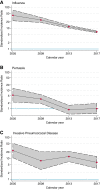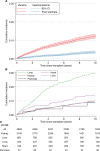Notifiable Infectious Diseases Among Organ Transplant Recipients: A Data-Linked Cohort Study, 2000-2015
- PMID: 35937651
- PMCID: PMC9348761
- DOI: 10.1093/ofid/ofac337
Notifiable Infectious Diseases Among Organ Transplant Recipients: A Data-Linked Cohort Study, 2000-2015
Abstract
Background: Infections, including common communicable infections such as influenza, frequently cause disease after organ transplantation, although the quantitative extent of infection and disease remains uncertain.
Methods: A cohort study was conducted to define the burden of notifiable infectious diseases among all solid organ recipients transplanted in New South Wales, Australia, 2000-2015. Data linkage was used to connect transplant registers to hospital admissions, notifiable diseases, and the death register. Standardized incidence ratios (SIRs) were calculated relative to general population notification rates, accounting for age, sex, and calendar year. Infection-related hospitalizations and deaths were identified.
Results: Among 4858 solid organ recipients followed for 39 183 person-years (PY), there were 792 notifications. Influenza was the most common infection (532 cases; incidence, 1358 [95% CI, 1247-1478] per 100 000 PY), highest within 3 months posttransplant. Next most common was salmonellosis (46 cases; incidence, 117 [95% CI, 87-156] per 100 000 PY), then pertussis (38 cases; incidence, 97 [95% CI, 71-133] per 100 000 PY). Influenza and invasive pneumococcal disease (IPD) showed significant excess cases compared with the general population (influenza SIR, 8.5 [95% CI, 7.8-9.2]; IPD SIR, 9.8 [95% CI, 6.9-13.9]), with high hospitalization rates (47% influenza cases, 68% IPD cases) and some mortality (4 influenza and 1 IPD deaths). By 10 years posttransplant, cumulative incidence of any vaccine-preventable disease was 12%, generally similar by transplanted organ, except higher among lung recipients. Gastrointestinal diseases, tuberculosis, and legionellosis had excess cases among transplant recipients, although there were few sexually transmitted infections and vector-borne diseases.
Conclusions: There is potential to avoid preventable infections among transplant recipients with improved vaccination programs, health education, and pretransplant donor and recipient screening.
Keywords: gastrointestinal infections; immunosuppression; sexually transmitted infections; solid organ transplantation; vaccine-preventable infections.
© The Author(s) 2022. Published by Oxford University Press on behalf of Infectious Diseases Society of America.
Figures




Similar articles
-
Vaccine-Preventable Infections Among Solid Organ Transplant Recipients in Switzerland.JAMA Netw Open. 2023 Apr 3;6(4):e2310687. doi: 10.1001/jamanetworkopen.2023.10687. JAMA Netw Open. 2023. PMID: 37115546 Free PMC article.
-
Incidence of Hospitalization for Vaccine-Preventable Infections in Children Following Solid Organ Transplant and Associated Morbidity, Mortality, and Costs.JAMA Pediatr. 2019 Mar 1;173(3):260-268. doi: 10.1001/jamapediatrics.2018.4954. JAMA Pediatr. 2019. PMID: 30640369 Free PMC article.
-
New blood-borne virus infections among organ transplant recipients: An Australian data-linked cohort study examining donor transmissions and other HIV, hepatitis C and hepatitis B notifications, 2000-2015.Transpl Infect Dis. 2020 Dec;22(6):e13437. doi: 10.1111/tid.13437. Epub 2020 Aug 27. Transpl Infect Dis. 2020. PMID: 32767859
-
Pneumococcal vaccination in adult solid organ transplant recipients: A review of current evidence.Vaccine. 2018 Oct 8;36(42):6253-6261. doi: 10.1016/j.vaccine.2018.08.069. Epub 2018 Sep 11. Vaccine. 2018. PMID: 30217523 Review.
-
Tuberculosis in Solid-Organ Transplant Recipients in Turkey: Meta-Analysis From the Tuberculosis Study Group of Turkish Transplantation Society, Solid Organ Transplantation Infections.Exp Clin Transplant. 2022 May;20(5):456-462. doi: 10.6002/ect.2020.0182. Epub 2021 Jan 11. Exp Clin Transplant. 2022. PMID: 33455571 Review.
Cited by
-
Pneumonia in Transplant Recipients: A Comprehensive Review of Diagnosis and Management.Cureus. 2024 Nov 14;16(11):e73669. doi: 10.7759/cureus.73669. eCollection 2024 Nov. Cureus. 2024. PMID: 39544950 Free PMC article. Review.
-
Psittacosis: An Underappreciated and Often Undiagnosed Disease.Pathogens. 2023 Sep 15;12(9):1165. doi: 10.3390/pathogens12091165. Pathogens. 2023. PMID: 37764973 Free PMC article. Review.
-
Rarely Encountered Gram-Negative Rods and Lung Transplant Recipients: A Narrative Review.Microorganisms. 2023 May 31;11(6):1468. doi: 10.3390/microorganisms11061468. Microorganisms. 2023. PMID: 37374970 Free PMC article. Review.
-
Bordetella bronchiseptica and Bordetella pertussis: Similarities and Differences in Infection, Immuno-Modulation, and Vaccine Considerations.Clin Microbiol Rev. 2023 Sep 21;36(3):e0016422. doi: 10.1128/cmr.00164-22. Epub 2023 Jun 12. Clin Microbiol Rev. 2023. PMID: 37306571 Free PMC article. Review.
-
Susceptibility to SARS-CoV-2 Infection and Immune Responses to COVID-19 Vaccination Among Recipients of Solid Organ Transplants.J Infect Dis. 2023 Aug 4;228(Suppl 1):S34-S45. doi: 10.1093/infdis/jiad152. J Infect Dis. 2023. PMID: 37539762 Free PMC article.
References
-
- Hogan J, Pietrement C, Sellier-Leclerc AL, et al. . Infection-related hospitalizations after kidney transplantation in children: incidence, risk factors, and cost. Pediatr Nephrol 2017; 32:2331–41. - PubMed
-
- Fishman JA. Infection in organ transplantation. Am J Transplant 2017; 17:856–79. - PubMed
-
- Kumar D, Humar A, Plevneshi A, et al. . Invasive pneumococcal disease in solid organ transplant recipients–10-year prospective population surveillance. Am J Transplant 2007; 7:1209–14. - PubMed

